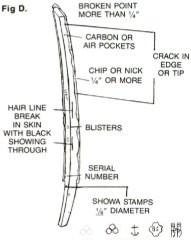Identification of swords requires removal of the TSUKA (handle), which may be accomplished by carefully forcing out the single tapered wooden peg (MEKUGI) which fastens it to the tang. The TSUKA may then be slid off the tang, revealing the maker’s signature and other identifying marks incised in the metal. The signature often consists of the maker’s name, his titles, and place at which the sword was make. The date of manufacture, when shown, is usually found on the other side of the tang. Certain patterns of file marks on the tang are also distinctive, aiding in determining the authenticity and dating of the sword.
Do not remove rust from tang!
Monetary value of the Japanese sword obviously depends upon many factors, such as; age, condition, maker and historical associations, but we can all appreciate the value of any of these swords as magnificent examples of the artistic ability and dedication of the Japanese sword smith.
Hamon (heat-treated) basic styles

Undesirable Blade Characteristics

Types of Swords and Daggers
Army Officers Katana
The Saya (scabbard) is usually painted olive drab in color. This type is also found with leather covered wood Saya. 50% chance for an old blade. Do not confuse the all metal handled N. C. O. type that has a serial numbered blade.
Naval Officer’s Model
The Navy sword is actually a copy of an Old Tachi. It can be easily identified by its SA-ME (occasionally simulated) covered Saya and two hangers. The location of Mons (crests) are the same as the Army sword. This type is also found with a leather covered wood Saya. 40% chance for an old blade.
Marine officer’s type
The main distinguishing points of this type are its Helmet designed caps (Kahria Kojuri). Its Saya is normally composed of brown lacquer over wood. 20% chance for an old blade.

Army Officers Sword (Russo-Japanese War)
This sword-comes in both Army and Navy models. The Tsukas (handles) are basically the same. There are also two sizes – Large (Katana blade), approximate handle length 10″, Small (Wakizashi blade), approximate handle size 6″. Both have visible Mekugi’s (retaining pegs). Do NOT confuse it with Parade or Police sabers (smaller handles, no Mekugi, dull blade). Swords in this type mounting carry old blades most of the time, and should never be passed over without a close examination. 95% chance for an old blade.
The blade in a Shira Saya (storage scabbard) should always be checked very closely. Most blades found in this type of mounting are very good quality, and could be very valuable. The Shirasaya will resemble a plain white wood cane, its purpose however, is to protect a blade prized too highly to be used in battle.

Ubu, Nakago, Mu-Mei
(virgin, tang, unsigned)There is normally a good reason for Ubu Nakago being unsigned, 90% of the time the blade either turned out with Kizu or it was a mass production blade. At any rate use caution in buying an unsigned sword with an Ubu Nakago.

O-Suriage
All of the original Nakago remains, only the Machi has been filed forward and a new Mekugi Ana (hole for the peg), has been added. The signature should be in the proximity of the original hole.

Machi-Okuri
(none of the original Nakago remaining) Note that when HI (grooves), are present that they go in the entire length of the tang.
Pictures and content may not be copied without the express permission of samuraisword.com ©


